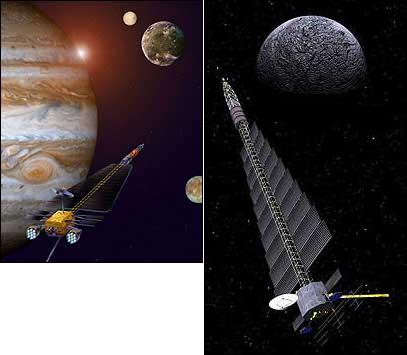will make it possible to overcome the lack of energy at the edge of the solar system

Artist's renderings of nuclear spacecraft reaching Jupiter's moons
NASA recently signed the first contract to develop a new generation of deep space probes that will accelerate a revolution in the study of the outer solar system.
As part of the new Prometheus project, the Lockheed Martin company won a $6 million contract to design a study called Jimo - an acronym for Jupiter Icy Moons Orbiter designed to study the large moons of Jupiter whose surface consists mainly of ice. As mentioned, the amount is only for the planning phase.
Project Prometheus is part of NASA's nuclear program designed to develop nuclear propulsion technology for solar system exploration.
A nuclear-powered JIMO spacecraft will for the first time allow a single spacecraft to reach the Jupiter system equipped with a large number of scientific instruments along with enough energy to allow it to explore each of the moons for a long period of time. The fuel will allow her to reach the coffee orbit around each such moon for an unlimited time and then leave it and go to the next moon. The spacecraft that have stayed at Jupiter so far have only orbited Jupiter with their orbit designed so that they would occasionally meet another moon for a one-time approach rather than a round.
Today, the limiting factor in exploring the outer solar system is the lack of enough power for the spacecraft to reach the area and the maneuvers it will perform when it gets there. For example, a spacecraft that will attack Europa, the icy moon of Jupiter that may contain primitive life forms. Currently, the planners can develop a spacecraft that will pass by Europa, but they do not have the technology to allow it to enter orbit.
To reach the outer solar system, the spacecraft have to use a slow approach flight technique that will take advantage of gravity and increase speed by approaching a planet and receiving a gravitational boost. This method has many limitations as to what such a spacecraft can do when it reaches the outer solar system.
The energy needed for operation can be easily provided through the use of nuclear power - heat from a decaying radioactive source provides energy. Conventional solar collectors are not effective beyond the orbit of Mars because the sunlight in these areas is too weak. It is therefore clear that astronomers need a new generation of technology if they are to seriously investigate what lies in the cold darkness of the edge of the solar system.
To overcome these problems and develop a new generation of spacecraft for deep space exploration, NASA plans to develop a nuclear energy source for use in places where the sun's energy is too weak, as well as a fission reactor to help in places where a large amount of energy is required.
During the research phase of the Prometheus project, many technologies will be tested for the reactor, the energy production system, the electric drive and the other aspects of the Jimo spacecraft and those that will follow it. Once the best technology is identified the next step will be to develop a more advanced design.
With the help of the new power technology it will be possible to achieve the scientific goals of orbiting the three icy moons of Jupiter - Callisto Ganymede and Europa.
The JIMO mission will be able to observe each of these moons for long periods and then move on to the next moon when the spacecraft still has electrical power to operate its sensors.
With such a spacecraft it will be possible to distinguish whether there are underground oceans on these moons. It will also be possible to map the location of organic compounds and other biologically interesting chemical substances, calculate the thickness of the ice layers, and find potential landing sites.
